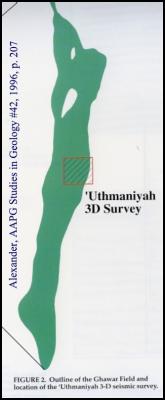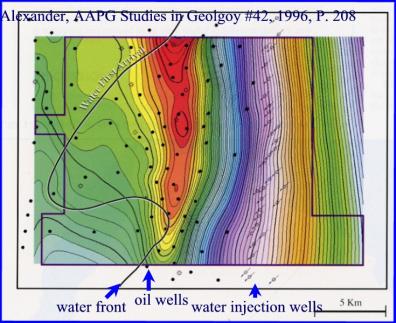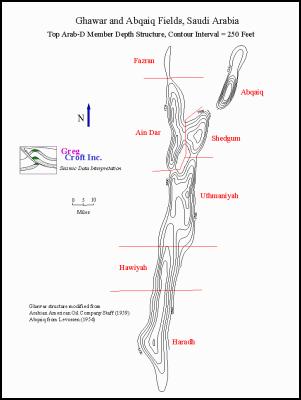Trouble in the World's Largest Oil Field - Ghawar
Trouble in the World's Largest Oil Field-Ghawar
By G.R. Morton
From: http://home.entouch.net/dmd/ghawar.htm
Copyright 2004 G.R. Morton This can be freely distributed so long as no changes are made and no charges are made.
There are four oil fields in the world which produce over one million barrels per day. Ghawar, which produces 4.5 million barrels per day, Cantarell in Mexico, which produces nearly 2 million barrels per day, Burgan in Kuwait which produces 1 million barrels per day and Da Qing in China which produces 1 million barrels per day. Ghawar is, therefore, extremely important to the world's economy and well being. Today the world produces 82.5 million barrels per day which means that Ghawar produces 5.5 percent of the world's daily production. Should it decline, there would be major problems. As Ghawar goes, so goes Saudi Arabia.
The field was brought on line in 1951. By 1981 it was producing 5.7 million barrels per day. Its production was restricted during the 1980s but by 1996 with the addition of two other areas in the southern area of Ghawar brought on production, Hawiyah and Haradh, the production went back up above 5 million per day. In 2001 it was producing around 4.5 million barrels per day. There have been 3400 wells drilled into this reservoir
I have noted elsewhere that the data I am being told by engineers who have actually worked on Ghawar, that this decade will see it's peak. (Morton, 2004 PSCF in press). Others have noted how the percentage of water brought up with the oil has been growing on Ghawar. There are published reports that Ghawar has from 30-55% water cut. This means that about half the fluids brought up the well are water. Today the decline rate is 8%. Thousands of barrels per day of production must be added each year.
"The big risk in Saudi Arabia is that Ghawar's rate of decline increases to an alarming point," said Ali Morteza Samsam Bakhtiari, a senior official with the National Iranian Oil Company. "That will set bells ringing all over the oil world because Ghawar underpins Saudi output and Saudi undergirds worldwide production." JEFF GERTH, "Forecast of Rising Oil Demand Challenges Tired Saudi Fields," February 24, 2004 New York Times, Late Edition - Final , Section A , Page 1 , Column 3 http://www.peakoil.net/Newspapers/20040224NYTTiredSaudiFields.doc
Unfortunately for the world, few know the actual state of Ghawar. Cumulative production from the field is 55 billion barrels. In 1975 Exxon, Mobil, Chevron and Texaco estimated that the ultimate recovery from the field would be 60 billion barrels. Without a doubt, new technologies have moved EURs from that which was possible in the mid 1970s. But the Saudis claim that the field can recover another 125 billion barrels.(this info comes from http://www.simmonsco-intl.com/files/IEA-SOM.pdf slide 25 accessed 7-5-04) For someone like me who has spent a lifetime in the oil industry trebling the recovery factor is a fantasy we all wish we could do. But no one has ever figured out how. Thus, I doubt very much their claims, especially in light of the maps shown below.
But this is what is happening
"Saudi oilmen are usually a taciturn bunch, guarding their data like state secrets. But this was post September 11 and Riyadh was wooing western journalists and trying to restore the Saudis' image as dependable, long-term suppliers of energy--not suicidal fanatics nor terrorist financiers. And it was working.
"Then the illusion slipped. On a whim I asked my hosts about another , older oilfield called Ghawar. It is the largest field ever discovered, its deep sandstone reservoir at one time had held perhaps one-seventh of the world's known oil reserves, and its well produced roughly one of every 12 barrels of crude consumed on earth. In the iconography of oi, Ghawar is the mythical giant that makes most other fields look puny and mortal. . . .
"At Ghawar,' he said, 'they have to inject water into the field to force the oil out,' by contrast, he continued, Shayba's oil contained only trace amounts of water. At Ghawar, the engineer said, the 'water cut' was 30%."
"The hairs on the back of my neck stood up. Ghawar's water injections were hardly news, but a 30% water cut, if true, was startling. Most new oilfields produce almost pure oil or oil mixed with natural gas--with little water. Over time, however, as the oil is drawn out, operators must replace it with water to keep te oil flowing --until eventually what flows is almost pure water and the field is no longer worth operating."
"Ghawar will not run dry overnight, but the beginning of the end of its oil is in sight." Paul Roberts, "New Tyrants for Old as the Oil Starts to Run Out, " Sunday Times (News Review), May 16, 2004, p. 8
But this year at the Offshore Technology Conference some were talking about a 55% water cut for Ghawar. Part of this is because the Saudi's inject large quantities of water into the reservoir and much of it comes back to the producing wells immediately though the system
"Saudi Aramco is injecting a staggering 7 million barrels of sea water per day back into Ghawar, the world's largest oilfield, in order to prop up pressure. It accounts for 30% of Saudi oil reserves and up to 70% of daily output." "Doubts grow about Saudi As Global Swing Producer," Aberdeen Press & Journal Energy, April 5, 2004, p. 15
But several people are becoming concerned about the ability of the Saudi's to maintain production. Here is a tidbit from the Aberdeen Scotland Newspaper of a few weeks ago.
"It seems a growing number of analysts are falling into line with the Simmons & Company International view that Saudi Arabia may be running out of steam and may not be able to perform the role of global swing producer for many more years, despite being credited with oil reserves in the order of 260 billion barrels. The Centre for Global Energy Studies hinted at the beginning of the year that the kingdom appeared to be heading for difficulties. Now one of its analysts has said that having reserves does not equate to production capacity. Citing the Haradh field, he said it required 500,000 barrels per day of water injection to get out 300,000 bpd of oil. Moreover the problem is even more serious in the Khurais field." "Doubts grow about Saudi As Global Swing Producer," Aberdeen Press & Journal Energy, April 5, 2004, p. 15
Since I am more and more working in the area of reservoir management, one of the things I have learned is that when you have to inject 500k barrels of water to get 300k barrels of oil, you will cycle water through that field like crazy. You won't up the pressure so you are probably cycling at least 200,000 barrels per day of water through the field.
For those who don't think there is a problem with the Saudi production, here are a couple of pictures of Ghawar from a 1996 report which shows the size of a 3d seismic section on the overall Ghawar field. The next picture is from the 3D showing the injection wells and the line in 1996 where the water had encroached
The Uthmaniyah area is the oldest producing area on Ghawar. But the next picture shows that to the right of the line the oil is gone and all that is left is water The solid circles are or were oil producers. the open circles with arrows through them are where the water is injected to the reservoir to push the oil towards the producers (On the picture below this is from the right to the left. You can see that in this area, in 1996 the water had encroached halfway across Ghawar.The water must have moved further to the west today, 8 years later.
the various areas of Ghwar are
outlined at a map found at:
http://web.inetba.com/gregcroftinc/images/Ghawar_map.gif
What is the future of Ghawar and Saudi production? It is not good.
"All production comes from 'very old fields', with no major exploration success since the 1960s, and almost every field has high and rising water cut.
"Saudi Aramco is injecting a staggering 7 million barrels of sea water per day back into Ghawar, the world's largest oilfield, in order to prop up pressure. It accounts for 30% of Saudi oil reserves and up to 70% of daily output." "Doubts grow about Saudi As Global Swing Producer," Aberdeen Press & Journal Energy, April 5, 2004, p. 15
and
"The Wocap simulations for Saudi oil are presented in Fig. 5. They clearly show a long plateau at 8-10 million b/d. Here the main question is: How long can Saudi Arabia plateau at that level? Or in other words: Will it age gracefully? Much will depend on Ghawar. “
“With 100 billion bbl of crude oil produced so far, Saudi Arabia should not be far from the midway point of its proved reserves of 260 billion bbl—that means just 10 years at the going rate of roughly 3 billion bbl/year. Bearing in mind the "spurious revision" of 1990 that boosted proved Saudi reserves to 257. billion bbl from 170 billion bbl, the midway point could happen even sooner than that. “
“Furthermore, the 35 billion bbl produced during 1990-2002 has not been accounted for, as Saudi "proved reserves" were still being reported at 260 billion bbl by the close of 2001. “A. M. Samsam Bakhtiari, “Middle East Oil Production to Peak within next decade.” Oil and Gas Journal, July 7, 2003, p. 24
One of the interesting things about Ghawar is the nature of its reservoir which provides an argument against an ideology I fight all the time, Young-earth Creationism. Ghawar is largely made of dung, which would be hard pressed to be concentrated during a global flood and thus contradicts the young-earth creationist claims.
“Most massive and nonporous limestones contain textures made by invertebrate animals that ingest sediment and turn out fecal pellets. Usually, the pellets get squished into the mud. Rarely do the fecal pellets themselves form a porous sedimentary rock. In the 1970s the first native-born Saudi to earn a doctorate in petroleum geology arrived for a year of work at Princeton. I used the occasion to twist Aramco’s collective arm for samples from the supergiant Ghawar field. As soon as the samples were ready, I made an appointment with our Saudi visitor to examine the samples together using petrographic microscopes. That morning, I was really excited. Examining the reservoir rock of the world’s biggest oil field was for me a thrill bigger than climbing Mount Everest. A small part of the reservoir was dolomite, but most of it turned out to be a fecal-pellet limestone. I had to go home that evening and explain to my family that the reservoir rock in the world’s biggest oil field was made of shit.” Kenneth S. Deffeyes, “Hubbert’s Peak” (Princeton: Princeton University Press, 2001), p. 57-58
Back to the serious issue of Ghawar, an almost poetic ode to the death of Ghawar can be found at http://www.newcolonist.com/ghawar.html. As Ghawar goes, so goes the world.
ENDS





 Martin LeFevre - Meditations: In A Global Society, There Is No Such Thing As “National Security”
Martin LeFevre - Meditations: In A Global Society, There Is No Such Thing As “National Security” Binoy Kampmark: Secrecy And Virtue Signalling - Another View Of Signalgate
Binoy Kampmark: Secrecy And Virtue Signalling - Another View Of Signalgate Gordon Campbell: On The Americanising Of NZ’s Public Health System
Gordon Campbell: On The Americanising Of NZ’s Public Health System Ian Powell: Trumpian Health Leadership
Ian Powell: Trumpian Health Leadership Eugene Doyle: Disruption - Historians Challenge Russophobic Propaganda
Eugene Doyle: Disruption - Historians Challenge Russophobic Propaganda Ramzy Baroud: War, Doublethink, And The Struggle For Survival - Geopolitics Of The Gaza Genocide
Ramzy Baroud: War, Doublethink, And The Struggle For Survival - Geopolitics Of The Gaza Genocide